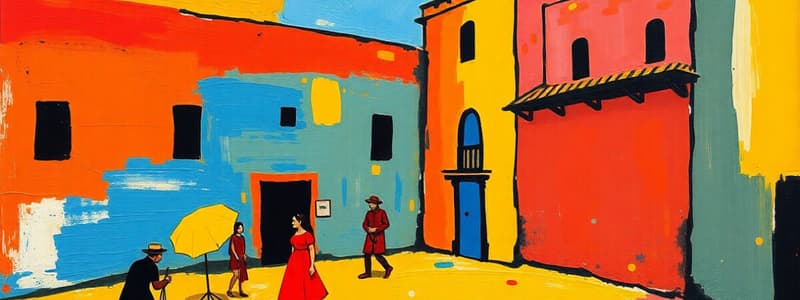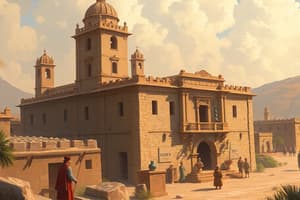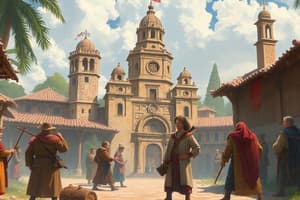Podcast
Questions and Answers
What significant event related to printing occurred between 1537 and 1539?
What significant event related to printing occurred between 1537 and 1539?
- The first book was printed in Spanish. (correct)
- A new printing technology was developed.
- The first book was printed in Latin.
- The first pamphlets were printed in English.
Which printing method was chiefly used during the time referenced in the content?
Which printing method was chiefly used during the time referenced in the content?
- Lithography
- Woodblock printing (correct)
- Typesetting
- Screen printing
What was a likely impact of the printing advances in the period mentioned?
What was a likely impact of the printing advances in the period mentioned?
- Increase in the circulation of literature. (correct)
- Reduction in the need for written manuscripts.
- Expansion of oral traditions.
- Decrease in literacy rates.
Who was mentioned as a key figure in the development of printing during this time?
Who was mentioned as a key figure in the development of printing during this time?
Which of the following was NOT a characteristic of literature during the early printing period?
Which of the following was NOT a characteristic of literature during the early printing period?
What can be inferred about the provisions mentioned in the content?
What can be inferred about the provisions mentioned in the content?
What impression did foreigners have regarding the quality of goods mentioned?
What impression did foreigners have regarding the quality of goods mentioned?
What does the term 'abundant' suggest about the resources available?
What does the term 'abundant' suggest about the resources available?
Which aspect of the local economy can be inferred from the provided information?
Which aspect of the local economy can be inferred from the provided information?
What was the significance of the year 1625 as mentioned in the content?
What was the significance of the year 1625 as mentioned in the content?
What is the primary theme of the passage?
What is the primary theme of the passage?
Which of the following groups are mentioned as having a significant contribution to the emergence of new artistic expressions in the Americas?
Which of the following groups are mentioned as having a significant contribution to the emergence of new artistic expressions in the Americas?
What does the passage suggest about the influence of the conquest on the development of cultural expression?
What does the passage suggest about the influence of the conquest on the development of cultural expression?
What is the meaning of the phrase "rud ~~" as used in the passage?
What is the meaning of the phrase "rud ~~" as used in the passage?
What is the significance of the phrase "Hisroru era 'I!" in the passage?
What is the significance of the phrase "Hisroru era 'I!" in the passage?
Flashcards
Colonial Institution
Colonial Institution
A type of educational institution founded during the Spanish colonial period, typically for the elite, with a focus on religious instruction and classical studies.
Native Americas
Native Americas
A term used to describe the indigenous populations of the Americas, often referencing their social structures and customs.
Transmission of Knowledge
Transmission of Knowledge
The process of transferring knowledge or skills from one person or group to another through teaching and learning.
Cultural Syncretism
Cultural Syncretism
Signup and view all the flashcards
Historical Inquiry
Historical Inquiry
Signup and view all the flashcards
Printing
Printing
Signup and view all the flashcards
Printing Era
Printing Era
Signup and view all the flashcards
First book printed
First book printed
Signup and view all the flashcards
Printing press
Printing press
Signup and view all the flashcards
Printing stakeholders
Printing stakeholders
Signup and view all the flashcards
Undue behavior
Undue behavior
Signup and view all the flashcards
Agitate
Agitate
Signup and view all the flashcards
Decry
Decry
Signup and view all the flashcards
Assembly
Assembly
Signup and view all the flashcards
Over gardens
Over gardens
Signup and view all the flashcards
Study Notes
Education in New Spain
- Education was not a state responsibility in Spain, usually handled by the church at the individual level, and the crown showing interest mainly for bureaucratic careers.
- Educational system was planned to aid Christianization and Spanish assimilation through education in the language.
- Don Antonio de Mendoza observed an Indian boy reciting in Latin, demonstrating the early focus on using education for Hispanicization.
- Pedro de Gante, a Franciscan, played a key role in educating indigenous boys.
- He founded San José school teaching trades and core subjects like Latin.
- He also guided in the building of 100 chapels and churches.
- Vasco de Quiroga established a school-hospital, promoting an ideal society and self-government for indigenous communities.
Cultural Vitality of New Spain
- Cultural developments were driven by learned clergymen.
- Laymen were often in government, law, or other professions.
- Early education was dominated by religious orders, providing intellectual and cultural attainments.
The School of Santa Cruz de Tlatelolco
- Founded in 1536 by Viceroy Mendoza and Bishop Zumárraga, fostering higher education for indigenous nobles aiming for cultural transmission.
- Including subjects like Latin, rhetoric, logic, philosophy, music, and native medicine.
Other Indian Schools and Education
- Jesuit San Gregorio Magno school trained Nahuas.
- Orphanage school of San Juan de Letrán helped mestizos.
Scholarship and Literature
- Early scholarship emerged with friars' inquiries into indigenous peoples and the land.
- Bernal Díaz del Castillo's Historia verdadera de la conquista de la Nueva España, a detailed account of the conquest written by a footsoldier in Cortés's army.
- Importance of early historians, like Motolinía, Sahagún, and Zorita, offering crucial knowledge of indigenous groups.
Studying That Suits You
Use AI to generate personalized quizzes and flashcards to suit your learning preferences.




